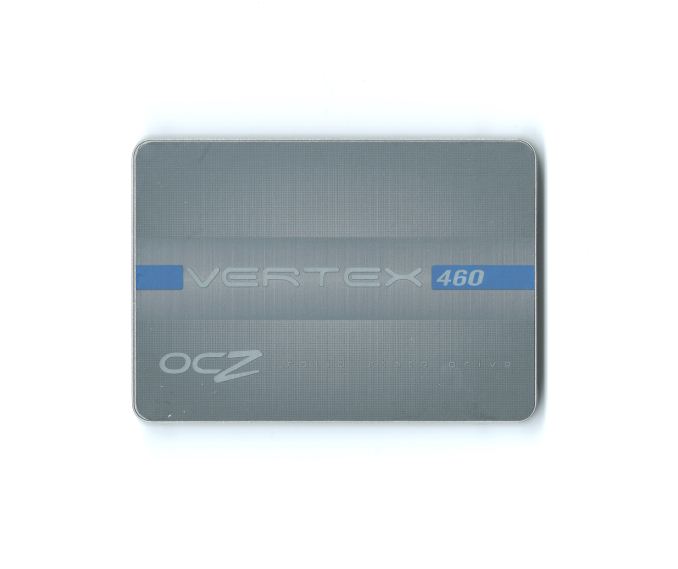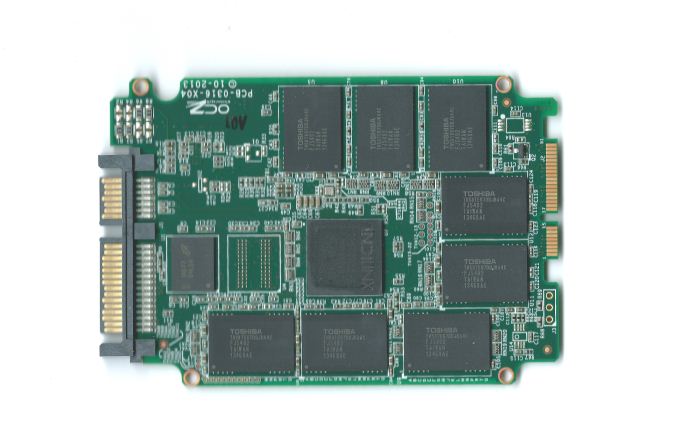OCZ Vertex 460 (240GB) Review
by Kristian Vättö on January 22, 2014 9:00 AM EST- Posted in
- Storage
- SSDs
- OCZ
- Indilinx
- Vertex 460

The last few months have not been easy at OCZ. After long-lasting financial issues, the company filed for bankruptcy on November 27th and a week later Toshiba announced that it will be acquiring the assets for $35 million.
Yesterday OCZ announced that the acquistion has been completed and were finally able to shed some lights to the details of the deal. To my surprise, OCZ will continue to operate as an independent subsidiary and won't be integrated into Toshiba's own SSD team. I'm guessing Toshiba sees financial potential in OCZ and is hence keeping things as they are. The only change aside from the change of ownership is a new brand logo and name: OCZ is now called OCZ Storage Solutions to further emphasize the focus of the company. Last time I heard OCZ was looking for a buyer for its PSU business but it seems they've not found one yet.
Update 1/31: We finally have an official statement regarding warranties.
Update 2/1: OCZ has a buyer for its PSU division and we'll have more details in a couple of weeks. The RAM and cooling divisions have been discontinued a long while ago, though.
| Comparison of OCZ's Barefoot 3 Based SSDs | ||||
| Vector 150 | Vertex 460 | Vector | Vertex 450 | |
| Controller | Indilinx Barefoot 3 | |||
| NAND | 19nm Toshiba | 19nm Toshiba | 25nm IMFT | 20nm IMFT |
| Over-Provisioning | 12% | 12% | 7% | 7% |
| Encryption | AES-256 | AES-256 | N/A | AES-256 |
| Endurance | 50GB/day for 5 years | 20GB/day for 3 years | 20GB/day for 5 years | 20GB/day for 3 years |
| Warranty | 5 years | 3 years | 5 years | 3 years |
The Vertex 460 resembles OCZ's flagship Vector 150 a lot. In terms of hardware the only difference between the two is that the Barefoot 3 controller in the Vertex 460 is slightly lower clocked than the one in Vector 150. The Barefoot 3 in the Vector 150 runs at 397MHz while in the Vertex 460 it's clocked at 352MHz. The speed of the controller isn't proportional to the overall performance but there are scenarios (like intensive read/write workloads) where a faster controller will help.
Both drives actually use exactly the same NAND (identical part numbers) but each Vector 150 goes through more testing and validation cycles to make sure the higher endurance criteria is met. Even though the NAND should be the same in both drives, bear in mind that endurance specifications are always minimums -- one part can be more durable than the other as long as both meet spec. By doing additional validation, OCZ is able to pick the highest endurance parts and use them in the Vector 150, whereas lower quality chips (but good enough to meet the mainstream endurance requirements) end up in the Vertex 460.
The choice of identical NAND in both models is indeed odd but I'm guessing that Toshiba had a hand in this. The Vertex 450 used Micron's NAND but obviously Toshiba doesn't want to use a competitor's NAND in their products, hence the Vertex 450 is replaced with the 460 and Toshiba NAND.
| OCZ Vertex 460 Specifications | |||
| Capacity | 120GB | 240GB | 480GB |
| Sequential Read | 530MB/s | 540MB/s | 545MB/s |
| Sequential Write | 420MB/s | 525MB/s | 525MB/s |
| 4KB Random Read | 80K IOPS | 85K IOPS | 95K IOPS |
| 4KB Random Write | 90K IOPS | 90K IOPS | 90K IOPS |
| Steady-State 4KB Random Write | 12K IOPS | 21K IOPS | 23K IOPS |
Similar to the Vector 150, the Vertex 460 switches to 12% over-provisioning. This seems to be an industry wide trend and to be honest I'm happy with that. The few percents extra makes a huge difference in terms of IO consistency, which in the end accounts for a better user experience.
Test System
| CPU | Intel Core i5-2500K running at 3.3GHz (Turbo and EIST enabled) |
| Motherboard | AsRock Z68 Pro3 |
| Chipset | Intel Z68 |
| Chipset Drivers | Intel 9.1.1.1015 + Intel RST 10.2 |
| Memory | G.Skill RipjawsX DDR3-1600 4 x 8GB (9-9-9-24) |
| Video Card | Palit GeForce GTX 770 JetStream 2GB GDDR5 (1150MHz core clock; 3505MHz GDDR5 effective) |
| Video Drivers | NVIDIA GeForce 332.21 WHQL |
| Desktop Resolution | 1920 x 1080 |
| OS | Windows 7 x64 |
Thanks to G.Skill for the RipjawsX 32GB DDR3 DRAM kit












69 Comments
View All Comments
dgingeri - Wednesday, January 22, 2014 - link
This thing has the same problem as my Vertex 4 drives. I'm not impressed. It essentially means that half the capacity is unusable due to the way the controller works.Guspaz - Wednesday, January 22, 2014 - link
Hrrm. Getting merged into Toshiba's SSD group is about the only thing that might have tempered my "never again" position on OCZ. By keeping them independent, they're doing nothing to convince me that they're going to change their ways. It's their own questionable decisions that got them into this mess (their reputation for poor reliability), sacrificing reliability at the alter of performance and shipping first.dgingeri - Wednesday, January 22, 2014 - link
You think the Toshiba name is good reliability? I have 224 enterprise hard drives that would say differently. Four years ago, I got 204 Fujitsu/Toshiba (just after Toshiba took over) 146GB 15k SAS drives. Over the course of the first three years, I replaced 165 of them, plus 19 of the replacements that came in as Toshiba branded drives with the same model number. After the warranty ended, I have had to replace the remaining ones by purchasing new ones. None of them are left now. All have been replaced with Seagate Saavios of the same size. They are worse than any desktop level hard drives I have dealt with in my career. I've only had one incident like it, and that was replacing Dell Optiplex motherboards with embedded TNT2-m64 chips back in 2000.Guspaz - Wednesday, January 22, 2014 - link
Seagate has rather questionable reliability themselves (see BackBlaze's recent study on this), but Toshiba's hard disk division is unrelated to their SSD division, so the reliability of one doesn't necessarily give any indication about the reliability of the other.dgingeri - Wednesday, January 22, 2014 - link
In the 2.5" enterprise hard drive market, Seagate has been top of the heap for a long time. They really do well in that arena. There aren't a whole lot of players in that arena, though. Only Seagate, Toshiba (formerly Fujitsu,) and Hitachi. Seagate's Saavio line happens to be the first line ever in 2.5" 10k or 15k drives.As far as desktop drives go, Seagate's desktop drives have had reliability problems for years, sure, but they aren't near as bad as Toshiba's desktop drives.
Dahak - Wednesday, January 22, 2014 - link
Wonder if ocz will use/can use toshiba's ssd team for addition support(firmware/validation)even though they are separate entitiesAlso found it funny that while reading this review I had ads for Crucial's SSD :)
MrSpadge - Wednesday, January 22, 2014 - link
Otherwise the aquisition wouldn't make much sense, would it? Keep them somewhat separate but use any synergetic benefits.Dahak - Wednesday, January 22, 2014 - link
I would think so too but the way it is worded in the article seems like they wontpiroroadkill - Wednesday, January 22, 2014 - link
Why don't you just review a rock or a potato? Because I doubt many people want to purchase OCZ products.toyotabedzrock - Wednesday, January 22, 2014 - link
It might be a good idea to not copy and paste the same explanation of the tests in every article.Just link to the information. It is just headache inducing that I have hunt for relevant information interleaved with the copy and pasted parts.